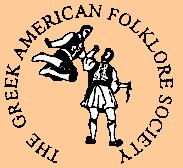Costumes: Thrace - Karoti
/The main components of the costume worn in Karoti, and in other villages where the same costume type is observed, is a home-made cotton chemise, embroidered around the hem line. A blue sleeveless, single-paneled, heavy cotton dress, thetsoukna, which had two openings to facilitate breast- feeding, was worn over the chemise. Another distinctive feature to the costume is the bronze belt, known as thebakirozounaro, accentuated by its ornamental bronze and enamel buckle, known as the korona. This type of belt is encountered only in the area of Thrace, and is hand-made by Thracean goldsmiths, called kouyioumtzides. The apron is wool, hand-woven with a geometrical design and sequins were applied to keep the Evil-Eye away. The costume also includes a beautiful head-dress known as the bourboula.
As a bridal costume, the color red is very predominant. Above the chemise a short red jacket is added. The sleeves of the jacket are adorned with yellow, green and blue needle-work. The woman's hair is also braided with brightly-colored ribbons. Real hair- pieces were added to lengthen the woman's hair. The head-piece consists of three scarves: the first, blue in color, covered the forehead; the second, yellow in color, fringed, draped under the chin and tied at the crown; the third, white in color, triangle in shape, was placed on top of the first two. To decorate the head-piece further, a rectangular hand-beaded piece was added to the left side of the temple. Coins were used to accent the forehead and adorn the bosom. Stockings were knitted from thick wool. Cloth slippers completed the ensemble.





